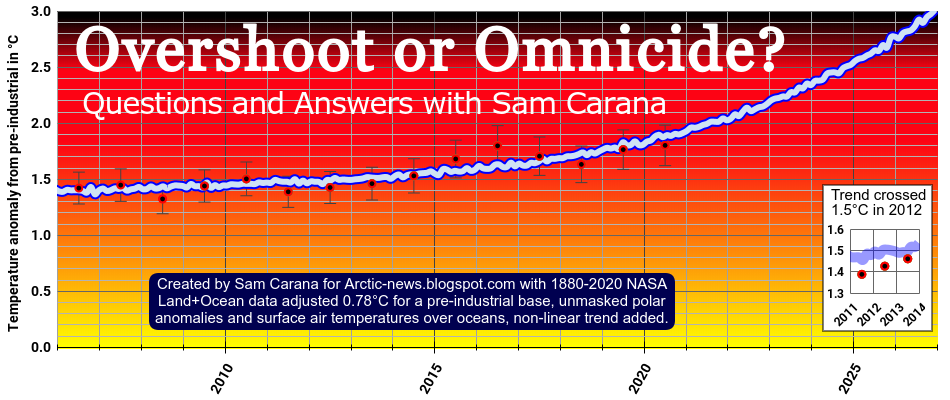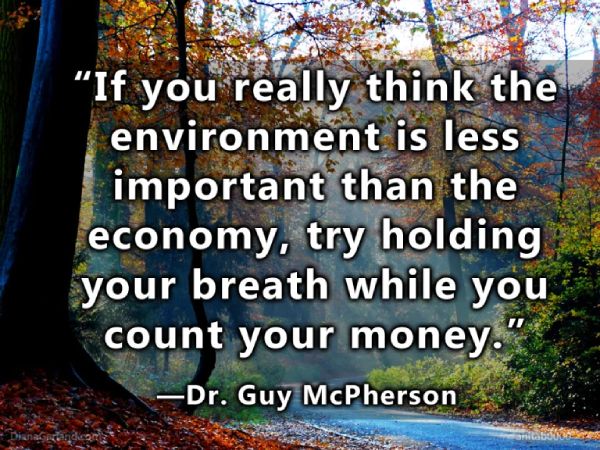Above image shows a non-linear trend based on 1880-2020 NASA Land+Ocean data that are adjusted 0.78°C to reflect a pre-industrial base, to more fully reflect strong polar warming, and to reflect surface air temperatures over oceans.
The trend highlights that the 1.5°C threshold was crossed in 2012 (inset), while the 2°C threshold looks set to be crossed next year and a 2°C rise could be reached at the end of 2026.
Overshoot?
The blue trend in the image at the top shows the temperature rise crossing 1.5°C in 2012. Could this be a temporary overshoot? Could temperatures come down in future, to such extent that this will bring the average temperature rise back to below 1.5°C?
An associated question is how much temperatures will rise when averaged over a 30-year period that is centered around the start of 2012? In other words, what is the average temperature rise from 1997 to end 2026?
The answer is that, for the 1997-2026 average to be below 1.5°C, temperatures would have to fall over the next few years. Even if the temperature for 2021 fell to a level as low as it was in 2018 and remained at that same lower level until end 2026, the 1997-2026 average would still be more than 1.5°C above pre-industrial.
Will temperatures rise over the next few years? Why? By how much?
Even if all emissions of greenhouse gases by people could magically end from one moment to another, temperatures would still continue to rise over the next few years. Reasons for this rise are listed below, and it is not an exhaustive list. By implication, there is no carbon budget left. Pretending that there was a carbon budget left, to be divided among polluters and to be consumed over the next few years, that suggestion is irresponsible.
• The warming impact of carbon dioxide reaches its peak a decade after emission, while methane's impact over ten years is huge, so the warming impact of the greenhouse gases already in the atmosphere is likely to prevent temperatures from falling and could instead keep raising temperatures for some time to come.
• Temperatures are currently suppressed. We're in a La Niña period, as illustrated by the image below.


• We're also at a low point in the sunspot cycle. As the image on the right shows, the number of sunspots can be expected to rise as we head toward 2026, and temperatures can be expected to rise accordingly.
• Add to this the impact of a recent Sudden Stratospheric Warming event. We are currently experiencing the combined impact of three short-term variables that are suppressing the temperature rise, i.e. a Sudden Stratospheric Warming event, a La Niña event and a low in sunspots.
Over the next few years, in the absence of large volcano eruptions and in the absence of Sudden Atmopsheric Warming events, a huge amount of heat could build up at surface level. As the temperature impact of the other two short-term variables reverses, i.e. as the sunspot cycle moves toward a peak and a El Niño develops, this could push up temperatures substantially. The world could be set up for a perfect storm by 2026, since sunspots are expected to reach a peak by then and since it takes a few years to move from a La Niña low to the peak of an El Niño period.
• Furthermore, temperatures are currently also suppressed by sulfate cooling. This impact is falling away as we progress with the necessary transition away from fossil fuel and biofuel, toward the use of more wind turbines and solar panels instead. Aerosols typically fall out of the atmosphere within a few weeks, so as the transition progresses, this will cause temperatures to rise over the next few years. Most sulfates are caused by large-scale industrial activity, such as coal-fired power plants and smelters. A significant part of sulphur emissions is also caused by volcanoes. Historically, some 20 volcanoes are actively erupting on any particular day. Of the 49 volcanoes that erupted during 2021, 45 volcanoes were still active with continuing (for at least 3 months) eruptions as at March 12, 2021.

• Also holding back the temperature rise at the moment is the buffer effect of thick sea ice in the Arctic that consumes heat as it melts. As Arctic sea ice thickness declines, more heat will instead warm up the Arctic, resulting in albedo changes, changes to the Jet Stream and possibly trigger huge releases of methane from the sea floor. The rise in ocean temperature on the Northern Hemisphere looks very threatening in this regard (see image on the right) and many of these developments are discussed at the extinction page. There are numerous further feedbacks that look set to start kicking in with growing ferocity as temperatures keep rising, such as releases of greenhouse gases resulting from permafrost thawing and the decline of the snow and ice cover. Some 30 feedbacks affecting the Arctic are discussed at the feedbacks page.
• The conclusion of study after study is that the situation is worse than expected and will get even worse as warming continues. Some examples: a recent study found that the Amazon rainforest is no longer a sink, but has become a source, contributing to warming the planet instead; another study found that soil bacteria release carbon dioxide previously thought to remain trapped by iron; and yet another study found that kelp off the Californian coast has collapsed.
Where do we go from here?
 |
| [ image from earlier post ] |
The same blue trend that's in the image at the top also shows up in the image on the right, from an earlier post, together with a purple trend and a red trend that picture even worse scenarios than the blue trend.
The purple trend is based on 15 recent years (2006-2020), so it can cover a 30-year period (2006-2035) that is centered around end December 2020. As the image shows, the purple trend points at a rise of 10°C by 2026, leaving little or no scope for the current acceleration to slow, let alone for the anomaly to return to below 2°C.
The red trend is based on a dozen recent years (2009-2020) and shows that the 2°C threshold could already have been crossed in 2020, while pointing at a rise of 18°C by 2025.
In conclusion, temperatures could rise by more than 3°C by the end of 2026, as indicated by the blue trend in the image at the top. At that point, humans will likely go extinct, making it in many respects rather futile to speculate about what will happen beyond 2026. On the other hand, the right thing to do is to help avoid the worst things from happening, through comprehensive and effective action as described in the Climate Plan. Links
• Climate Plan https://arctic-news.blogspot.com/p/climateplan.html
• NOAA Global Climate Report - February 2021 - Monthly Temperature Anomalies Versus El Niño https://www.ncdc.noaa.gov/sotc/global/202102/supplemental/page-4
• NOAA Northern Hemisphere Ocean Temperature Anomaly https://www.ncdc.noaa.gov/cag/global/time-series/nhem/ocean/12/12/1880-2021
• NOAA Sunspots - solar cycle progression https://www.swpc.noaa.gov/products/solar-cycle-progression
• Smithsonian Institution - Volcanoes - current eruptions https://volcano.si.edu/gvp_currenteruptions.cfm
• 2020: Hottest Year On Record https://arctic-news.blogspot.com/2021/01/2020-hottest-year-on-record.html
• What Carbon Budget? https://arctic-news.blogspot.com/2021/01/what-carbon-budget.html
• Most Important Message Ever https://arctic-news.blogspot.com/2019/07/most-important-message-ever.html
• High Temperatures October 2020 https://arctic-news.blogspot.com/2020/10/high-temperatures-october-2020.html
• Temperature keep rising https://arctic-news.blogspot.com/2020/12/temperatures-keep-rising.html
• More Extreme Weather https://arctic-news.blogspot.com/2021/02/more-extreme-weather.html
• Extinction https://arctic-news.blogspot.com/p/extinction.html
• Feedbacks https://arctic-news.blogspot.com/p/feedbacks.html
• Sudden Stratospheric Warming https://arctic-news.blogspot.com/p/sudden-stratospheric-warming.html
• Iron mineral dissolution releases iron and associated organic carbon during permafrost thaw - by Monique Patzner et al. https://www.nature.com/articles/s41467-020-20102-6
• Large-scale shift in the structure of a kelp forest ecosystem co-occurs with an epizootic and marine heatwave - by Meredith McPherson et al. https://www.nature.com/articles/s42003-021-01827-6
• Global maps of twenty-first century forest carbon fluxes - by Nancy Harris et al. https://www.nature.com/articles/s41558-020-00976-6
• Maximum warming occurs about one decade after a carbon dioxide emission by Katharine Ricke et al. https://iopscience.iop.org/article/10.1088/1748-9326/9/12/124002
• Confirm Methane's Importance https://arctic-news.blogspot.com/2021/03/confirm-methanes-importance.html• FAQshttps://arctic-
![]() Don't forget to feed the birds. Donate here
Don't forget to feed the birds. Donate here









